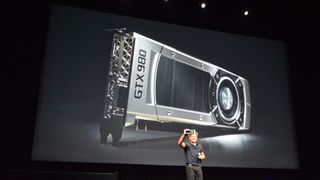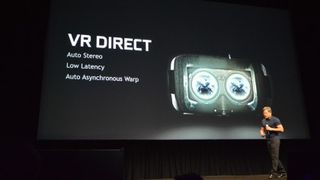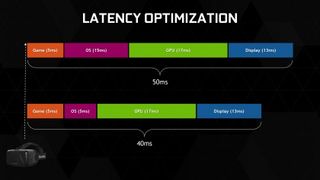Nvidia jumps into virtual reality with GeForce GTX 980 and 970
Virtual reality is looking better and better

The marriage between PCs and virtual reality is stronger than ever thanks to the latest graphics card from Nvidia.
During Nvidia's inaugural 24-hour PC gaming event, Game24, CEO Jen-Hsun Jeng revealed the GeForce GTX 980 and 970 GPUs.
The Maxwell architecture in the 980 and 970 boasts several new and impressive features but the head turner is definitely the integration of VR Direct.
This new feature makes Nvidia the first hardware company to put virtual reality software into its GPUs - though likely not the last.
During the event, we spoke with Justin Walker, Senior Product Manager who further explained the concept of VR Direct on the new Maxwell GPU.

Virtual reality SLI
SLI played a big role in figuring out what to do with VR's latency issues.
Walker says: "SLI would work but the thing with SLI is that you do alternate frame rendering on one GPU and then the next frame rendering, going back and forth. In a normal environment, that can inject a little bit of latency."
Get daily insight, inspiration and deals in your inbox
Get the hottest deals available in your inbox plus news, reviews, opinion, analysis and more from the TechRadar team.

Meaning on a screen, your frame rate goes up so much that you don't even notice or care. However with VR, any delays between gameplay and head movement are sure to make you nauseous and ruin your experience.
Which is something Walker notes, "you want to get rid of."
This is where SLI and VR come into play: "So we developed VR SLI basically, where you can actually assign each one of the GPUs to each eye. By doing that you don't have a latency effect anymore because you're literally just going from one [GPU] directly to each eye."
More at play
Nvidia also plans on cutting down VR latency by implementing new tech called MFAA - Multi-Frame sampled Anti-Aliasing - which produces 4x's multisample anti-aliasing images at 2x MSAA speeds.

NVIDIA's Dynamic Super Resolution (DSR) technology will be also available to VR which should significantly help reduce aliasing on today's panels. MFAA and DSR should be available after the 980's launch where the latter will roll out as an update to older graphics cards.

Lastly, asynchronous warp or JIT WARP (just in time Windows Advanced Rasterization Platform) allows sampling of head tracking to run smoother by cutting latency directly in half. Expect your GeForce GTX 980 and 970 GPUs to start running asynchronous warp software a bit later though, when more virtual reality devices actually hit the shelves.
Future of VR
It's already apparent that virtual reality isn't going anywhere but the advent of new hardware made specifically for VR has further cemented its future. With the Oculus Rift being the most prominent headset, it's no surprise Nvidia worked with the Oculus to create VR Direct.
Though Walker says, "Oculus isn't exclusively working with Nvidia because they have a whole PC ecosystem to worry about."
He then quickly pointed out that "they [Oculus] benefit a lot because they need the performance; they really need the latency, and we're the ones that deliver that better than anyone else, in particular with Maxwell. Maxwell is going to be the GPU you want if you're doing VR because we've put a lot of focus on fine tuning the process."
Since Nvidia is the first company to out VR GPUs, we think it's OK to boast a bit, but but we're sure plenty of other GPU companies won't be far behind.
Most Popular

